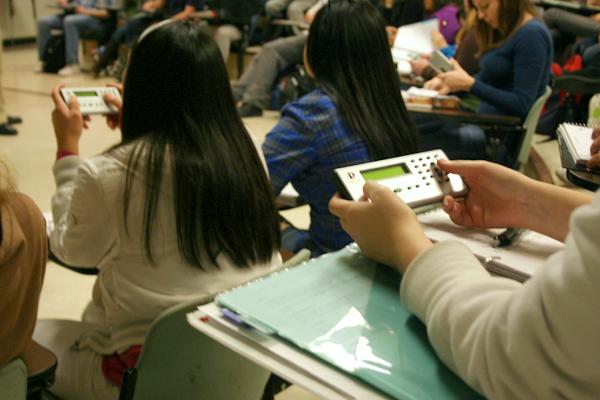One click away

Chris Taylor’s astronomy class uses clickers to answer questions on Feb. 2.:Claire Padgett
February 12, 2009
Bookstore sales for classroom response systems, or clickers, have almost doubled over the last few semester as professors have begun to implement them in more sections.
The clicker, a small remote response device, works by transmitting a radio frequency, or infrared signal, to the receiver attached to the instructor’s computer. The receiver then inputs the students’ answers into the teacher’s computer, and is organized by software made by the same manufacturer.
Clickers were first introduced to the education system in the late 1980s, and are now being used campus wide by eleven Sacramento State professors who teach two to sometimes more than five sections each.
According to the Hornet Bookstore’s Course Tracks textbook management system, 523 more clickers were sold in the fall 2008 semester than in the spring 2008 semester.
Shelly Olsen, manager of the textbook department in the Hornet Bookstore, said she has sold 1019 clickers this semester, and plans on selling several hundred more as students continue to buy their required class supplies.
Most clickers can cost anywhere between $20 and $30 upfront and require an additional online registration fee of about $15 per semester. The costs vary for each brand of clicker used. If a student pays $43 upfront to register a clicker, the student can use the clicker for an unlimited amount of semesters, or they can wait until they accumulate $45 in registration fees to receive the same privilege. Each online registration fee covers an entire semester of clicker usage, and an unlimited amount of classes as long as the instructors are assigning the same brand of clicker.
Student reactions to the price of the clicker vary according to how many books the instructors require for each class.
Freshman Ethan Perez has used the clickers twice since the start of the semester.
“The $13 online registration fee is kind of a downside,” Perez said.
However, sophomore math major Brandon Yragni said he did not complain about its price and registration fee because “compared to my calculus class’s $180 textbook, this is all I have to pay for and I’m cool with that.”
Currently there are four brands of clickers being used at Sac State, and neither are compatible with one another. Thus, a student might be forced to pay for two clickers and two registrations fees or more in one semester, a problem the Center for Teaching and Learning at Sac State will be addressing.
The Center for Teaching and Learning is currently promoting one brand of clicker, the CPS Gen, and is trying to universalize this model clicker on campus by offering demonstrations, trainings and technical support.
The clickers are mainly used by the chemistry, philosophy and criminal justice departments. Each of the 11 instructors using the clickers is responsible for managing more than 110 students spread over several sections.
Chemistry professor Jeffrey Mack uses the clicker in two sections of General Chemistry I with more than 100 students in each section.
Mack said the clickers allow him to take attendance, track student progress and engage students who might otherwise remain silent.
“The clickers provide students the ability to answer questions with anonymity, so that they don’t get embarrassed,” Mack said.
Jane E. Caldwell, in her research paper, “Clickers in the Large Classroom: Current Research and Best-Practice Tips,” agreed that the idea of anonymity is important in the classroom.
Caldwell found that many instructors adopt the clicker to help passive students become more engaged, and to combat one-way communication during lectures. Caldwell also found that most instructors use the clickers to keep students from losing concentration.
Mack gives students six questions in each class period and tracks student progress based on the answers.
“[Clickers] give me feedback so that I can catch at-risk students early,” Mack said.
Junior biology major Erika Pearce said she enjoys using the clickers in her chemistry class, but only uses it in that one class.
“It’s a good way to get you to pay attention,” she said.
David Gutierrez can be reached at [email protected]




























































































































